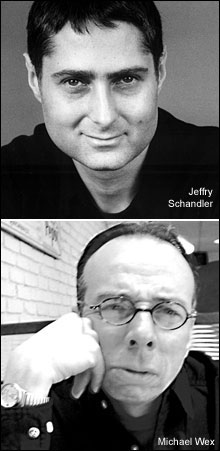Shandler surveys a deep catalog of contemporary Yiddishland residents and artifacts — from Yiddish board games and Yiddish theater festivals to Yiddish translators — in order to show how it has become a language of collective re-invention. Speak Yiddish not because you already live where it’s spoken, but to create the place itself — to live in Yiddishland.
 And yet for all of Shandler’s vibrant Yiddishland touring, the most popular book about Yiddish in decades, Michael Wex’s Born To Kvetch, isn’t postvernacular at all: it’s a celebration of Yiddish as a spoken language, and it’s written by a Yiddish speaker. Where Shandler maps the worlds spun out from Yiddish, Wex is entrenched in the etymological and grammatical cosmos of the language itself, and he delivers embedded riffs and rants straight from the moaning belly of the Germanic beast. Although Wex’s theme-by-theme flights through Yiddish as an endlessly playful, endlessly complaining language game can get exhausting by book’s end, Yiddish in his hands is brimming with life — a Yiddishland from within the vernacular itself.
And yet for all of Shandler’s vibrant Yiddishland touring, the most popular book about Yiddish in decades, Michael Wex’s Born To Kvetch, isn’t postvernacular at all: it’s a celebration of Yiddish as a spoken language, and it’s written by a Yiddish speaker. Where Shandler maps the worlds spun out from Yiddish, Wex is entrenched in the etymological and grammatical cosmos of the language itself, and he delivers embedded riffs and rants straight from the moaning belly of the Germanic beast. Although Wex’s theme-by-theme flights through Yiddish as an endlessly playful, endlessly complaining language game can get exhausting by book’s end, Yiddish in his hands is brimming with life — a Yiddishland from within the vernacular itself.
Wex is most revelatory in his early chapters. Here he positions the birth of Yiddish in 10th-century Germany by Italian and French Jews (who eventually headed to the Slavic East), and he argues that, from the start, the language captured the mood of three earlier stages of Jewish life: an art of complaint that dates back to the Torah (“What is Hebrew prophecy but kvetching in the name of God?”), a history of exile with Jews as perpetual outsiders (“Judaism is defined by exile, and exile without complaint is tourism”), and a tradition of Talmudic oral interpretation that laid the groundwork for Yiddish’s fluid syntax and questioning speech (“The Talmud is nothing less than Yiddish in utero”).
Shandler’s idea of Yiddishland as a virtual country where Jewish identity is shaped gets echoed in Born To Kvetch, only here, Wex argues that the vernacular birth of Yiddish itself was linked to a desire by Jews in medieval Germany to distinguish themselves from their gentile neighbors. Calling Yiddish “German to spite the Germans, a German that Germans wouldn’t understand,” he urges, “Don’t think of Yiddish as a blend of German and Semitic elements; think of it as a horror movie.” Yiddish, then as now, was not a language Jews spoke, but a language that made Jews Jews.
To riff on Wex’s riff on William S. Burroughs: Yiddish is neither a virus nor a dybbuk to ward off Linda Blair. It is people and homeland at once. It is complaint and longing spilling off tongues that — in the age of both the National Yiddish Book Center and Yiddish refrigerator poetry — are still trying to find new ways to speak.
ADVERTISEMENT
 |